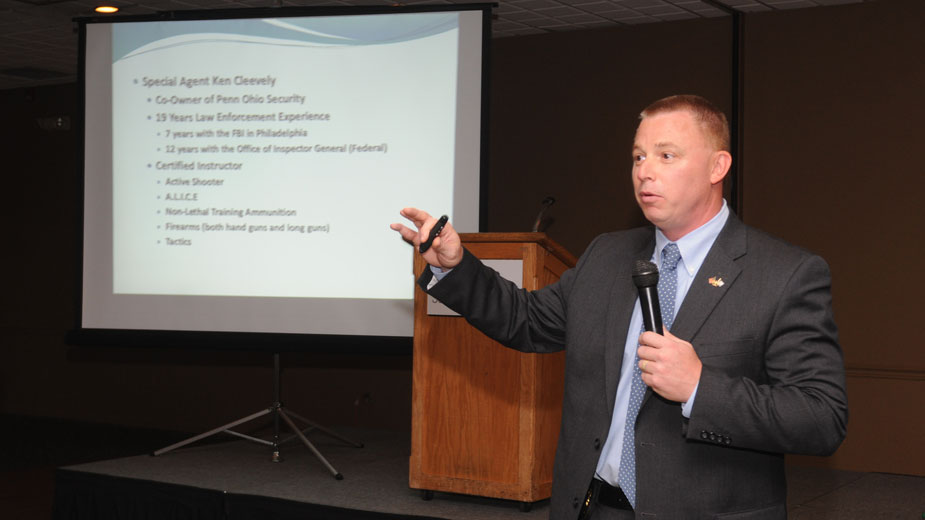Businesses Hear How to Survive Active Shooter
BOARDMAN, Ohio – The perpetrators behind mass shootings such as last weekend’s massacre at a nightclub in Orlando, Fla., are becoming more sophisticated. That means businesses and institutions, as well as the general public, need to step up their ability to respond, a security expert says.
The topic of the June meeting of the Mahoning Valley Safety Council – “Surviving an Active Shooter” — had added relevance in the wake of the attack, which left 50 dead (including the shooter) and 53 wounded. Ken Cleevely, owner of Penn Ohio Security LLC in Struthers, addressed the luncheon held at Antone’s Banquet Center.
Cleevely, who has more 17 years of law enforcement experience including seven with the FBI, was booked six months ago, said Karen Stacey, executive director of leadership and safety programs at the Youngstown Warren Regional Chamber, which manages the safety council program.
“It couldn’t be more timely,” she remarked.
“These attackers, they’re getting better at what they’re doing,” Cleevely said. “The death total in Orlando was evidence of that. … These guys are getting better and becoming more prepared.” In response, law enforcement has changed its tactics but the general public must also change.
Cleevely presented sobering statistics to the 240 in attendance, including 30 who had booked since the weekend, Stacey said. According to an FBI study, 70% of the active shooter incidents from 2000 to 2013 occurred in a school or business. He also said assaults and violent acts are the second-leading cause of workplace deaths.
And between 1992 and 2010, there have been 468 school-associated violent deaths, including 348 resulting from shootings. During the same period, he noted, the number of school-related fire deaths has been zero. In fact, he pointed out, there hasn’t been one since 1958.
“So we practice fire drills,” he remarked.
The most common cause of an active-shooter event is “denial. We ignore it and we don’t prepare for it,” Cleevely said.
He offered examples of the active-shooter episodes at the Sandy Hook Elementary School in Connecticut in 2012 and Virginia Tech in 2007 to illustrate the flaws in past responses to such situations. Such “old-school” responses as locking the door of a room, sitting on the floor and waiting for law enforcement to arrive “are not going to cut it anymore,” he said.
In both incidents, the shooter had killed more than two dozen victims before law enforcement reached them.
He detailed a set of actions known by the acronym ALICE – Alert, Lock-down, Inform, Counter and Evacuate — that was created by a police officer and his wife, a school administrator, to respond to such scenarios.
The ALICE actions aren’t to be executed in any particular order, just as needed, he pointed out.
Examples of an alert include a call to 9-1-1, a public address announcement or even loud screaming.
Alerts can be good or bad, Cleevely said, should someone simply announce on a P.A. system that a lockdown is in effect without elaborating why. Such an alert “really doesn’t tell you anything,” he said. An alert stating that the shooter is in a specific area gives his targets the power to act, such as escaping through another area.
“Running from the threat is the best thing you can do. If you can evacuate, evacuate,” he advised, invoking another component of the acronym. Shooters look for easy targets so they can kill as many people as they can, not to “chase you down the hall,” he added.
Lockdown calls on individuals not simply to lock themselves into a space but also to barricade such a space by using “everything in that room that isn’t nailed down” so the shooter can’t enter. In addition to using heavy objects to thwart entry, computer cables can be used to secure doors.
“You’ve got to be creative. These are things you should be thinking about,” he said.
“When lockdown fails and evacuation is not an option, counter,” he stressed.
Action steps include screaming, throwing objects, diverting attention and attacking. An attack on the shooter should be the “last resort,” he stated. Some in the group might be injured in the attack but “most of you are not going to be harmed,” he said.
Cleevely showed a video of a recent attempted child abduction in a Walmart in Georgia. The 7-year-old girl kicked and screamed until the would-be kidnapper ran off.
“If this little girl can fight back, we should be able to fight back in an active-shooter situation,” he said.
Stacey said attendance at yesterday’s luncheon included 20 walk-ins, more than normal for a safety council luncheon. “Our program manager’s phone has been ringing off the hook,” she said.
Kathy Samsa, human resources manager at TMK IPSCO in Brookfield, said she will “definitely be educating” plant employees about how to respond in an active-shooter scenario based on the presentation.
“Being in HR, you’re always concerned about the safety of everybody and how can we train everybody to protect themselves better,” she said.
As an addiction treatment company, Meridian HealthCare, has hundreds of people walk through its doors every day, said Jerry Burnett, director of facilities. Over the years, he said, he has attended several classes related to the subject, “long before recent event,” but noted that such situations likely will continue.
“Society’s presented us with a situation we have to deal with,” Burnett said.
“The more training that we can give back to our staff and out visitors in our sites, the more relevant it is,’ he added. “I learned today that the time response is critical. A minute or two makes a big difference.”
Pictured: Ken Cleevely, owner of Penn Ohio Security LLC in Struthers, addresses Wednesday’s meeting of the Mahoning Valley Safety Council.
Copyright 2024 The Business Journal, Youngstown, Ohio.


